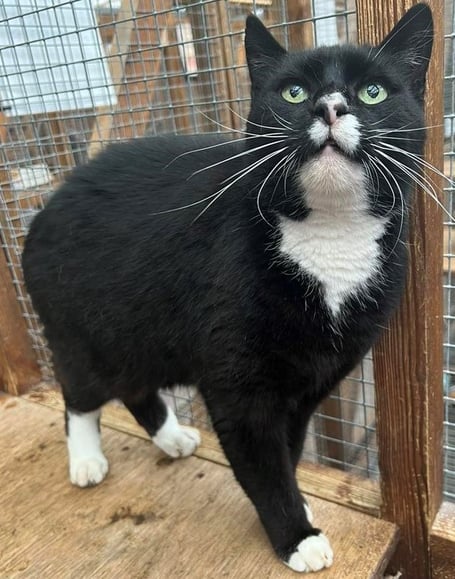Why do cats have tails? A pertinent question this week because our ‘animal of the week’, Cauldron, doesn’t have one.
A cat’s tail has lots of uses and is an important part of their physiological and psychological wellbeing.
A tail helps a cat to balance, particularly when they are walking or running along a narrow surface such as fence, or when they are jumping on prey.
The tail acts as a counter balance, and so when a cat swerves to the right its tail will swing to the left; and when the cat jumps upwards its tail will go down. In fact, the length of a cat’s tail is proportionate to its overall body size precisely so that it can adequately manage the cat’s balancing needs.
A tail helps a cat communicate, and it is a key indicator of mood – a stiff, upright tail is a sign that a cat is frightened; a tail being swished is usually a sign that the cat is displeased and that you should leave them alone; and a tail that is up in the air and curved a bit like a question mark is often a signal that the cat is in a playful mood.
A tail can provide an extra layer of warmth when a cat is sleeping, which is why you will often see a recumbent feline curled up with its tail wrapped around its face and body.
A tail helps a cat understand its surroundings and, like whiskers, enables them to feel and sense the environment to assess if it’s safe or comfortable. The nerves in a cat’s tail also send signals to its brain to help it co-ordinate a reaction, enabling it to have a lightning-quick response system. Tails are such a sensitive part of a cat’s body that most cats do not like them to be touched or stroked (and they should never be pulled, even playfully), and if a long-haired tail needs to be brushed this should be done with great care.
A tail helps a cat get attention – sometimes they will coil their tails around an owner’s legs, or if a favourite human is lying down they may find a cat’s tail brushing against their face.
A tail helps a cat to mark its territory. It contains scent glands (caudal glands) that a cat can rub onto its surroundings as a signal to other cats.
An injury to a cat’s tail can result in great pain, and sometimes a vet will have no alternative but to amputate it.
This is what happened to Cauldron (also known as Sox) after he was involved in a car accident several years ago.
He also sustained some nerve damage which means he has slight incontinence, although he is a very clean and fastidious cat. His previous owner had him for 12 years from a kitten, and managed Cauldron’s toileting issues by keeping him outside for much of the time.
This may not be necessary in Cauldron’s new home provided his owner understands that there may be the odd ‘accident’.
Cauldron’s previous owner moved in with his partner who is severely allergic to cats, and so he couldn’t keep his much-loved companion of many years. He describes Cauldron as playful, affectionate, friendly and happy (despite not having his tail) - simply a great cat to have around. He has lived with another cat in the past, but he doesn’t like dogs.
As is often the case at this time of year when our cattery has had lots of kittens to rehome, older cats like Cauldron have been overlooked in favour of the youngsters. At least with a more mature cat you know what you’re getting because their personalities have developed – as such, Cauldron is guaranteed to be a loyal and loving companion.
If you would like to meet Cauldron, please visit the cattery between 1pm and 4pm any day except for Mondays and Thursdays.

.png?width=209&height=140&crop=209:145,smart&quality=75)
-(1).jpeg?width=209&height=140&crop=209:145,smart&quality=75)


Comments
This article has no comments yet. Be the first to leave a comment.